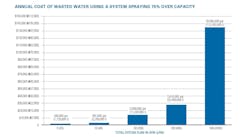Three Surefire Ways to Cut Costs (And Save the World)
The demand for resource preservation and sustainability is unavoidable--particularly in this election season climate.
Manufacturers across the market are fighting to improve sustainability, reduce their carbon footprints, and, especially, reduce their water and chemical usage.
It's a fact of life for modern manufacturing. And besides, it's the right thing to do.
But there is more to it than just that.
Pursuing greater sustainability in daily operations isn't just good for the environment; it can also offer some significant financial payback for your company in the process.
"It's a win-win," explains Dave Kouwe, Director of marketing at Spraying Systems Co. "When you can do the right thing and make some positive impact on your own operations, that's a great thing,"
Spraying Systems Co. is in a unique position to see this in action.
Spraying equipment, Kouwe notes, is an often neglected part of a manufacturer's sustainability efforts.
"Often, it's not even on their radar," he says. "Most people don't even realize just how much water or chemicals they may be using and they may not have considered what opportunities they have to reduce that volume."
And that, he says, can be a costly oversight.
"Nozzles wear out," he explains. "These are precision engineered spray orifices. They wear out over time; when they wear out, flow increases. "
Unless you are carefully monitoring these systems, he says, this wear can add up to 15% above the intended flow rates, even in critical processes—basically dumping gallons of water or expensive lubricants and coatings down the drain.
The cost of this waste can add up quickly.
To combat this issue, Spraying Systems Co. has put together three tips to help ensure that your operation is getting the most from its spray systems:
1. CONFIRM YOU ARE USING THE RIGHT NOZZLES FOR YOUR OPERATION
If you’ve been using the same nozzles for a few years, find out if there are newer versions available. Even if you aren’t experiencing problems, you may find new nozzle designs are available that offer greater efficiency and longer wear life.
New automatic spray nozzles and anti-bearding nozzle designs are two recent advancements in spray technology that can optimize performance in many applications. You should also explore the following options:
- Clog-resistant designs to minimize performance problems and unscheduled downtime.
- Quick-connect styles to reduce maintenance time.
- Alternate nozzle materials to extend wear life Remember, the nozzle is the heart of your spray operation.
Verifying nozzle selection is the best investment you can make in your spray system.
2. ESTABLISH A ROUTINE SPRAY SYSTEM MAINTENANCE PROGRAM
Neglecting your spray system can cost you thousands – even hundreds of thousands – of dollars annually. Even worse, most people don’t realize that quality problems and rising operating costs are often due to using worn spray nozzles – components that can easily be replaced at relatively low cost.
Spray nozzles, like any precision component, will wear with use causing flow rate to increase and performance to decline.
Visual detection of nozzle wear is nearly impossible unless the wear is very significant. A quick spot check to see if nozzles are spraying often won’t reveal the problem.
In addition to inspecting individual nozzles, be sure to monitor the performance of your pumps, piping, valves and filtration equipment. All of these components affect the overall performance of your spray system.
3. CONSIDER THE VALUE OF AUTOMATED SPRAY CONTROL
Automating your spray operation will often result in liquid savings and dramatic production improvements.
A simple automation project such as installing tank cleaning nozzles to eliminate manual cleaning of tanks, totes and processing vessels can pay big dividends.
An automated spray system including a dedicated spray controller is another way to add precision to many operations.
Spray control options range from simple systems that provide on/off control and automatic air and liquid control to sophisticated systems that provide closed-loop control of spray operations with automatic adjustments.
This type of real-time monitoring of spray performance reduces the need for manual inspection of many systems.
It is important to understand what benefits you may gain from spray control and evaluate the options available. Automated spray control may sound costly but most users find the investment is offset very quickly by reduced water and chemical costs, increased production, reduced scrap rate and more.
Another Handy Tool
Want to know just how much your worn spray nozzles are costing your company? Log on to spray.com/save to try out Spraying Systems Co.'s spray calculator. Plug in your operation stats and see where you can save.
Read more about these tips in Spraying Systems Co.'s latest whitepaper, "Strategies to Reduce Your Water and Chemical Costs."
About the Author
Travis Hessman
VP of Content, Endeavor Business Media
Travis Hessman is the VP of Content for Endeavor Business Media. Previously, Travis was the Editor-in-Chief for Industry Week and New Equipment Digest as well as the Group Editorial Director for Endeavor's Manufacturing Group.
He began his career as an intern at IndustryWeek in 2001 and later served as IW's technology and innovation editor. Today, he combines his experience as an educator, a writer, and a journalist to help address some of the most significant challenges in the manufacturing industry, with a particular focus on leadership, training, and the technologies of smart manufacturing.


